Simple Tips for Growing Herbs in Containers
Growing herbs in containers is a popular gardening option for those who have limited space or want to have easy access to their favorite herbs right outside their doors. Whether you have a small balcony, patio, or even just a sunny windowsill, growing herbs in containers is a convenient and rewarding way to enjoy fresh flavors in your cooking. Here are some simple tips to help you successfully grow herbs in containers.
1. Choose the right container: Selecting the appropriate container size and material is crucial for successful herb growing. Make sure your container has good drainage holes to prevent waterlogged roots. Additionally, choose pots that are at least 6-8 inches deep to provide enough soil volume for root development.
2. Pick the suitable herbs: Consider the herbs you use the most in your cooking or the ones that appeal to your senses. Popular container-friendly herbs include basil, parsley, rosemary, thyme, mint, chives, and cilantro. Keep in mind that some herbs grow better together while others may require separate pots due to varying needs.
3. Optimal sunlight exposure: Most herbs need at least six hours of direct sunlight daily. Place your containers in an area that receives sufficient light throughout the day. South-facing balconies or patios are ideal spots if available; otherwise, consider investing in grow lights if you don’t have access to ample sunlight.
4. Quality potting mix: Choose a well-draining potting mix specifically formulated for containers as regular garden soil tends to become compacted and drains poorly when used alone. Good quality potting mix ensures adequate air circulation and retains moisture without becoming waterlogged.
5. Watering routine: Herbs generally prefer consistent moisture levels without being overly soaked or completely dried out. Water your containers when the top inch of soil feels dry to the touch but avoid overwatering as it can lead to root rot or fungal diseases.
6. Fertilize appropriately: Use a balanced organic or slow-release fertilizer to nourish your herbs. Applying a diluted liquid fertilizer every few weeks during the growing season helps promote healthy growth and abundant foliage.
7. Pruning and harvesting: Regularly trimming your herbs promotes bushier growth and prevents them from becoming leggy. Snip off any flowers that appear to divert the plant’s energy towards foliage production rather than seed formation. Harvesting herbs encourages new growth, so be sure to pick leaves regularly, taking care not to remove more than one-third of the plant at a time.
8. Pest control: Keep an eye out for common herb pests such as aphids, whiteflies, or spider mites. Regularly inspect your plants for any signs of infestation and take appropriate measures such as using insecticidal soap or neem oil to deter pests.
By following these simple tips, you can successfully grow an herb garden in containers regardless of your gardening experience or available space. Not only will you have fresh flavors at your fingertips, but the vibrant green foliage of these herbs will also add beauty and life to your outdoor or indoor spaces. So, get started on your container herb garden today and enjoy the many benefits it brings!













